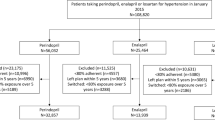Abstract
Background
The presence of angiotensin receptor blockers (ARBs) on the formularies of Medicare Part D prescription drug plans (PDPs) is vitally important to the health of seniors who cannot tolerate angiotensin-converting enzyme (ACE) inhibitors.
Objective
To determine whether ARBs are present on the formularies of PDPs and how the prescription cost-sharing for ARBs under Part D compares to cost-sharing before Part D.
Design/Participants
Cross-sectional analyses of March 2006 Medicare Part D formularies (n = 1,446) and of ARB utilization and cost-sharing for adults over the age of 64 included in the nationally representative Medical Expenditure Panel Survey.
Main Outcome Measures
(1) Presence of ARBs on Part D formularies. (2) Average out-of-pocket costs for 30-day supply of ARBs before and after Part D (both in 2006 dollars).
Results
All PDP formularies included at least 1 ARB. Most plans covered 2 ARBs (41%) and 35% covered all 7. The average monthly copay for the most commonly used ARB, valsartan, is $28 under part D, $14 before Part D for individuals with prescription coverage, and $53 before Part D for individuals without coverage.
Conclusions
Whereas ARBs are present on all Part D formularies, many seniors will pay more for these drugs under Part D. Any savings in copayments under Part D may be erased by the monthly premium and by more expensive cost-sharing when seniors reach the ‘donut hole’.

Similar content being viewed by others
References
United States Pharmacopeial Convention Inc. Medicare Prescription Drug Benefit Model Guidelines. Drug Categories and Classes in Part D; 2004 December 31.
Bach PB, McClellan MB. The first months of the prescription-drug benefit—a CMS update. N Engl J Med. 2006;354(22):2312–4.
Hoadley J, Hargrave E, Cubanski J, Neuman T. An in-depth examination of formularies and other features of Medicare drug plans. The Henry J. Kaiser Family Foundation. April 2006. (Accessed at http://www.kff.org/medicare/upload/7489.pdf.)
Huskamp HA, Keating NL. The new medicare drug benefit: formularies and their potential effects on access to medications. J Gen Intern Med. 2005;20(7):662–5.
Tokmakova M, Solomon SD. Inhibiting the renin–angiotensin system in myocardial infarction and heart failure: lessons from SAVE, VALIANT and CHARM, and other clinical trials. Curr Opin Cardiol. 2006;21(4):268–72.
Sica DA. ACE inhibitor intolerance and lessons learned from the candesartan in heart failure: assessment of reduction in mortality and morbidity (CHARM) trials. Congest Heart Fail. 2004;10(3):160–4.
Barnett AH, Bain SC, Bouter P, et al. Angiotensin-receptor blockade versus converting-enzyme inhibition in type 2 diabetes and nephropathy. N Engl J Med. 2004;351(19):1952–61.
Elliott WJ. Higher incidence of discontinuation of angiotensin converting enzyme inhibitors due to cough in black subjects. Clin Pharmacol Ther. 1996;60(5):582–8.
Kostis JB, Kim HJ, Rusnak J, et al. Incidence and characteristics of angioedema associated with enalapril. Arch Intern Med. 2005;165(14):1637–42.
Shrank WH, Hoang T, Ettner SL, et al. The implications of choice: prescribing generic or preferred pharmaceuticals improves medication adherence for chronic conditions. Arch Intern Med. 2006;166(3):332–7.
Retiree Health Benefits Examined: Findings from the Kaiser/Hewitt 2006 Survey on Retiree Health Benefits. December 2006. (Accessed at http://www.kff.org/medicare/upload/7587.pdf.)
Safran DG, Neuman P, Schoen C, et al. Prescription drug coverage and seniors: findings from a 2003 national survey. Health Aff (Millwood, Va.) 2005;Suppl Web Exclusives:W5-152–W5-66.
Consumer Price Index. Federal Reserve Bank of Minneapolis. (Accessed at http://woodrow.mpls.frb.fed.us/research/data/us/calc/hist1913.cfm.)
Cohen SB, DiGaetano R, Goskel H. Estimation procedures in the 1996 medical expenditures panel survey household component. Rockville, MD: Agency for Health Care Policy and Research; 1999. Report No.: 99-0027.
Conlin PR, Spence JD, Williams B, et al. Angiotensin II antagonists for hypertension: are there differences in efficacy? Am J Hypertens. 2000;13(4 Pt 1):418–26.
Frakt AB, Pizer SD. A first look at the new medicare prescription drug plans. Health Aff (Millwood, Va.). 2006;25(4): 252–61.
Gold M. Premiums and Cost-Sharing Features in Medicare’s New Prescription Drug Program. The Henry J. Kaiser Family Foundation. May 2006. (Accessed at http://www.kff.org/medicare/7517.cfm.)
Hsu J, Price M, Huang J, et al. Unintended consequences of caps on medicare drug benefits. N Engl J Med. 2006;354(22):2349–59.
Tseng CW, Brook RH, Keeler E, et al. Cost-lowering strategies used by medicare beneficiaries who exceed drug benefit caps and have a gap in drug coverage. JAMA. 2004;292(8):952–60.
Mojtabai R. Medication costs, adherence, and health outcomes among medicare beneficiaries. Health Aff (Millwood, Va.). 2003;22(4):220–9.
Acknowledgments/Financial Support
This work was supported by the Agency for Healthcare Research and Quality (P01 HS10771 and P01 HS 10856). Dr. Gellad was supported by an Institutional National Research Service Award #5T32 HP11001-18.
Potential Conflicts of Interest
None Disclosed.
Author information
Authors and Affiliations
Corresponding author
Rights and permissions
About this article
Cite this article
Gellad, W.F., Huskamp, H.A., Phillips, K.A. et al. Angiotensin Receptor Blockers on the Formularies of Medicare Drug Plans. J GEN INTERN MED 22, 1172–1175 (2007). https://doi.org/10.1007/s11606-007-0235-z
Received:
Revised:
Accepted:
Published:
Issue Date:
DOI: https://doi.org/10.1007/s11606-007-0235-z




